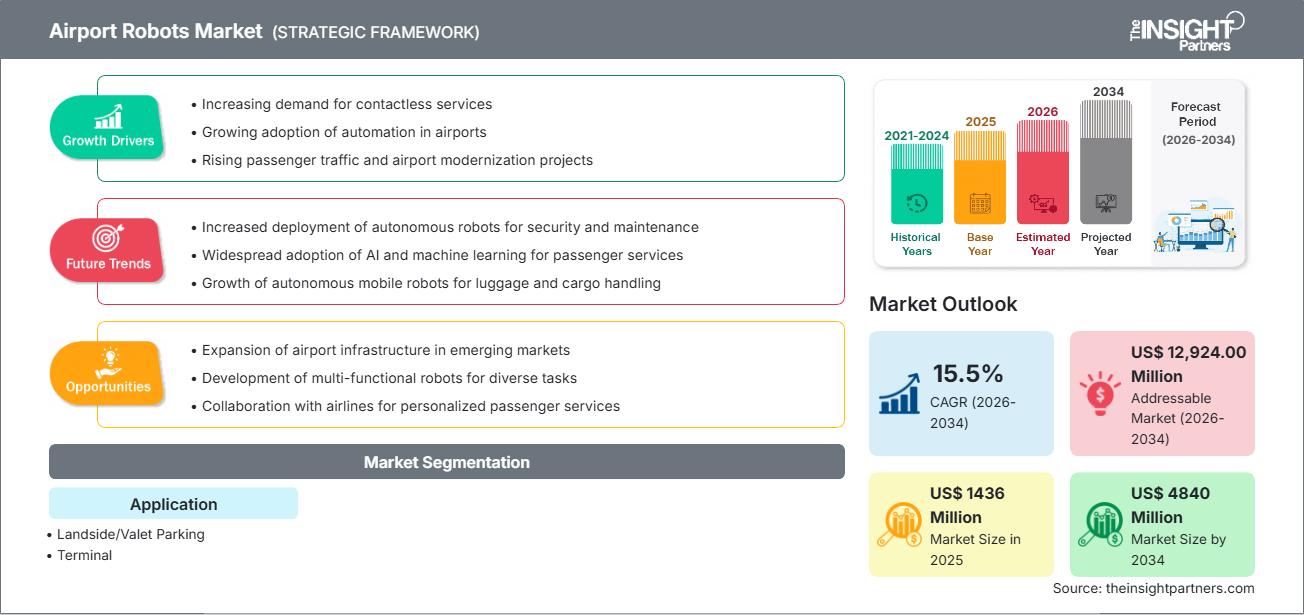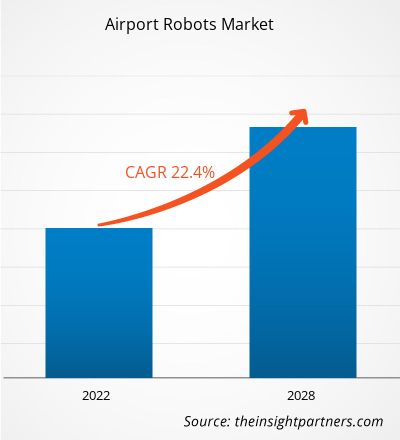Si prevede che il mercato dei robot aeroportuali crescerà da 1.436 milioni di dollari nel 2025 a 4.840 milioni di dollari nel 2034, registrando un CAGR del 15,5% durante il periodo di previsione (2026-2034).
Analisi del mercato dei robot aeroportuali
La crescente automazione negli aeroporti, la crescente consapevolezza in materia di sicurezza, la pressione sui costi del lavoro e la crescente richiesta di migliori esperienze per i passeggeri guideranno la rapida crescita del mercato dei robot aeroportuali. Gli aeroporti implementano sempre più robot di servizio per l'assistenza ai passeggeri, la pulizia, la movimentazione dei bagagli e persino la sicurezza, per ridurre la dipendenza dal lavoro umano e garantire flussi di lavoro fluidi. L'integrazione di intelligenza artificiale, visione artificiale, riconoscimento facciale e sensori avanzati accelera ulteriormente questa crescita.
Inoltre, i forti investimenti nelle infrastrutture aeroportuali in tutto il mondo, soprattutto nei mercati emergenti, insieme ai piani di modernizzazione dei governi, continuano a trainare la domanda. I robot non solo migliorano l'efficienza operativa, ma contribuiscono anche a migliorare la sicurezza e l'igiene, aspetti diventati ancora più critici in un mondo post-COVID.
Panoramica del mercato dei robot aeroportuali
I robot aeroportuali sono sistemi robotici specializzati, autonomi o semi-autonomi, impiegati negli aeroporti con compiti che spaziano dall'assistenza ai passeggeri, ai controlli di sicurezza, alla movimentazione dei bagagli e alla pulizia, fino all'esecuzione di numerose altre funzioni operative. Questi robot contribuiscono ad automatizzare molti processi ripetitivi e ad alta intensità di risorse, migliorando l'efficienza dei servizi e riducendo così la manodopera e i rischi operativi.
Con l'aumento del traffico passeggeri e le aspettative di un'esperienza aeroportuale senza contatto e senza interruzioni, questi sistemi robotici svolgono un ruolo fondamentale nella modernizzazione del funzionamento degli aeroporti. La loro adozione riguarda sia l'esperienza di viaggio front-end, come chioschi informativi e servizi di orientamento, sia le operazioni di back-end, come pulizia, sorveglianza e logistica.
Personalizza questo report in base alle tue esigenze
Riceverai la personalizzazione gratuita di qualsiasi report, incluse parti di questo report, analisi a livello nazionale, pacchetto dati Excel e potrai usufruire di fantastiche offerte e sconti per start-up e università.
Mercato dei robot aeroportuali: approfondimenti strategici

-
Scopri le principali tendenze di mercato di questo rapporto.Questo campione GRATUITO includerà analisi dei dati, che spaziano dalle tendenze di mercato alle stime e alle previsioni.
Driver e opportunità del mercato dei robot aeroportuali
Fattori trainanti del mercato:
- Automazione della sicurezza e rilevamento delle minacce: l'aumento delle minacce alla sicurezza spinge gli aeroporti a impiegare robot dotati di sensori, telecamere e riconoscimento facciale per monitorare la folla, rilevare anomalie e cercare merci di contrabbando.
- Imperativi di efficienza operativa: gli aeroporti sono sottoposti a continue pressioni per ridurre i costi di manodopera e ottimizzare le operazioni; i robot possono svolgere compiti instancabilmente, riducendo la dipendenza dalla manodopera manuale per la pulizia, la movimentazione dei bagagli e la sorveglianza.
- Espansione e modernizzazione delle infrastrutture: molti governi stanno investendo nella costruzione o nell'ampliamento di aeroporti, offrendo opportunità per integrare la robotica fin dalle prime fasi della progettazione. Ad esempio, il rapporto di The Insight Partners rileva che la costruzione di nuovi aeroporti in paesi come Cina e India rappresenta una leva di crescita significativa.
Opportunità di mercato:
- Crescita nei mercati emergenti: il rapido sviluppo e l'aumento della capacità aeroportuale nelle economie emergenti forniscono un terreno fertile per l'impiego dei robot.
- Integrazione di intelligenza artificiale e visione: l'utilizzo dell'intelligenza artificiale per la navigazione, l'interazione vocale e l'analisi della folla può rendere i robot aeroportuali più intelligenti e aumentarne l'utilità per i ruoli a contatto con i passeggeri.
- Innovazione dei servizi: esiste il potenziale per ampliare i casi d'uso, ad esempio l'assistenza multilingue ai passeggeri, il traino autonomo dei bagagli, la pulizia e i robot autonomi per il parcheggio.
- Partnership con OEM di robotica: gli aeroporti possono collaborare con produttori di robotica e aziende di intelligenza artificiale per sviluppare congiuntamente soluzioni robotiche su misura, ottimizzate per i loro layout, profili dei passeggeri e requisiti normativi.
Analisi della segmentazione del rapporto di mercato dei robot aeroportuali
La segmentazione seguente segue la struttura solitamente utilizzata nell'analisi di The Insight Partners:
Per applicazione:
- Parcheggio lato terra / Parcheggio con servizio di ritiro e riconsegna auto
- terminale
Per geografia:
- America del Nord
- Europa
- Asia Pacifico
- America meridionale e centrale
- Medio Oriente e Africa
Approfondimenti regionali sul mercato dei robot aeroportuali
Le tendenze e i fattori regionali che hanno influenzato il mercato dei robot aeroportuali durante il periodo di previsione sono stati ampiamente spiegati dagli analisti di The Insight Partners. Questa sezione analizza anche i segmenti e la geografia del mercato dei robot aeroportuali in Nord America, Europa, Asia-Pacifico, Medio Oriente e Africa, America Meridionale e Centrale.
Ambito del rapporto sul mercato dei robot aeroportuali
| Attributo del report | Dettagli |
|---|---|
| Dimensioni del mercato nel 2025 | 1.436 milioni di dollari USA |
| Dimensioni del mercato entro il 2034 | 4840 milioni di dollari USA |
| CAGR globale (2026 - 2034) | ?15,5% |
| Dati storici | 2021-2024 |
| Periodo di previsione | 2026-2034 |
| Segmenti coperti |
Per applicazione
|
| Regioni e paesi coperti |
America del Nord
|
| Leader di mercato e profili aziendali chiave |
|
Densità degli attori del mercato dei robot aeroportuali: comprendere il suo impatto sulle dinamiche aziendali
Il mercato dei robot aeroportuali è in rapida crescita, trainato dalla crescente domanda degli utenti finali, dovuta a fattori quali l'evoluzione delle preferenze dei consumatori, i progressi tecnologici e una maggiore consapevolezza dei vantaggi del prodotto. Con l'aumento della domanda, le aziende stanno ampliando la propria offerta, innovando per soddisfare le esigenze dei consumatori e sfruttando le tendenze emergenti, alimentando ulteriormente la crescita del mercato.

- Ottieni una panoramica dei principali attori del mercato dei robot aeroportuali
Analisi della quota di mercato dei robot aeroportuali per area geografica
Il rapporto di The Insight Partners fornisce una ripartizione regionale per mostrare come la domanda varia nelle diverse aree geografiche:
America del Nord
- Quota di mercato e importanza: storicamente leader nell'adozione grazie alla solida infrastruttura aeronautica, agli elevati standard di sicurezza e alla maggiore spesa pro capite in tecnologia.
- Fattori chiave: conformità normativa, pressioni sui costi del lavoro e integrazione della robotica nelle operazioni a contatto con i passeggeri e di back-end.
Europa
- Quota di mercato e importanza: forte presenza grazie ad aeroporti avanzati e ad elevati standard di sicurezza e normativi.
- Fattori chiave: attenzione all'automazione, alla sostenibilità e all'efficienza nelle operazioni aeroportuali.
Asia Pacifico
- Traiettoria di crescita: si prevede che la regione sarà in forte crescita, sostenuta dal rapido sviluppo delle infrastrutture aeroportuali, dalla forte crescita dei passeggeri e da politiche governative favorevoli.
- Tendenze: adozione di robot dotati di intelligenza artificiale per l'assistenza ai passeggeri, la sicurezza e la pulizia; aumento delle collaborazioni con le aziende di robotica.
America meridionale e centrale
- Potenziale di mercato: settore dell'aviazione in crescita; potenziale di adozione della robotica con la costruzione o l'ammodernamento di nuovi aeroporti.
Medio Oriente e Africa
- Opportunità: ambiziosi piani di espansione dell'aeroporto; crescente interesse per le tecnologie aeroportuali avanzate per la gestione di grandi volumi di passeggeri e per la sicurezza.
Densità degli attori del mercato dei robot aeroportuali: comprendere il suo impatto sulle dinamiche aziendali
Strategie competitive osservate:
- Partnership tra aeroporti e OEM di robotica per la creazione congiunta di robot personalizzati.
- Lo sviluppo di robot più autonomi e guidati dall'intelligenza artificiale che massimizzano il valore riducendo al minimo l'intervento.
- Particolare attenzione all'interoperabilità: integrazione dei robot con i sistemi di gestione aeroportuale, i protocolli di sicurezza e i sistemi di dati dei passeggeri.
- Sottolineare l'affidabilità dei robot, la durata della batteria e le certificazioni di sicurezza per soddisfare le severe normative aeronautiche.
Opportunità e mosse strategiche:
- I fornitori possono collaborare con i governi per sfruttare i programmi di modernizzazione degli aeroporti.
- Sviluppo congiunto di robot multilingue a contatto con i passeggeri per migliorare l'esperienza del cliente e la differenziazione del servizio.
- Investire in ricerca e sviluppo per ridurre i costi dei robot (hardware + software) e rendere le implementazioni economicamente sostenibili anche per gli aeroporti più piccoli.
Attori chiave del mercato:
- YUJIN ROBOT Co., Ltd.
- Avidbots Corp.
- CYBERDYNE INC.
- Robotica SoftBank
- Stanley Robotics SAS
- SITA
- ABB Ltd
- Gruppo ECA
- LG Electronics
Altri attori del mercato analizzati durante la ricerca:
- Universal Robots A/S
- Siemens AG
- Gruppo Thales
- Vanderlande Industries
- Boston Dynamics
- Honeywell International Inc.
- KUKA AG
- BlueBotics SA
- Robot UVD
Notizie e sviluppi recenti sul mercato dei robot aeroportuali
- Il rapporto di Insight Partners evidenzia un crescente interesse e l'impiego di robot di sicurezza dotati di riconoscimento facciale e capacità di telerilevamento in diversi aeroporti.
- Stanley Robotics ha implementato sistemi robotici autonomi per il parcheggio nei parcheggi degli aeroporti, liberando spazio a terra e aumentando l'efficienza.
- Gli aeroporti delle economie emergenti (ad esempio in Asia) stanno investendo sempre di più in robot per l'assistenza ai passeggeri e per la pulizia, spinti sia dall'espansione della capacità sia dalla necessità di servizi senza contatto.
- Gli OEM stanno sviluppando sistemi robotici di nuova generazione con una maggiore durata della batteria, una migliore navigazione basata sull'intelligenza artificiale e interazioni multimodali (voce + tocco) per soddisfare i diversi profili dei passeggeri.
Copertura e risultati del rapporto sul mercato dei robot aeroportuali
Il rapporto "Airport Robots Market – Forecast to 2034" di The Insight Partners copre:
- Dimensioni e previsioni del mercato globale e regionale (2021-2034)
- Dinamiche di mercato: fattori trainanti, vincoli, opportunità e tendenze
- Valutazione dell'impatto del COVID-19 sull'adozione della robotica aeroportuale
- Analisi della segmentazione: per tipo, applicazione, utente finale, geografia
- Analisi PEST (Politica, Economica, Sociale, Tecnologica) e analisi SWOT
- Panorama competitivo: concentrazione del mercato, mappa termica dei principali attori, strategie
- Profili aziendali dettagliati dei principali attori: SITA, SoftBank Robotics, Stanley Robotics, ABB, LG Electronics, CYBERDYNE, Yujin Robot, ecc.
- Analisi storica (2 anni), anno base, previsione (7 anni) con CAGR
- Analisi PEST e SWOT
- Valore/volume delle dimensioni del mercato - Globale, Regionale, Nazionale
- Industria e panorama competitivo
- Set di dati Excel
Report recenti
Testimonianze
Motivo dell'acquisto
- Processo decisionale informato
- Comprensione delle dinamiche di mercato
- Analisi competitiva
- Analisi dei clienti
- Previsioni di mercato
- Mitigazione del rischio
- Pianificazione strategica
- Giustificazione degli investimenti
- Identificazione dei mercati emergenti
- Miglioramento delle strategie di marketing
- Aumento dell'efficienza operativa
- Allineamento alle tendenze normative






















 Ottieni un campione gratuito per - Mercato dei robot aeroportuali
Ottieni un campione gratuito per - Mercato dei robot aeroportuali